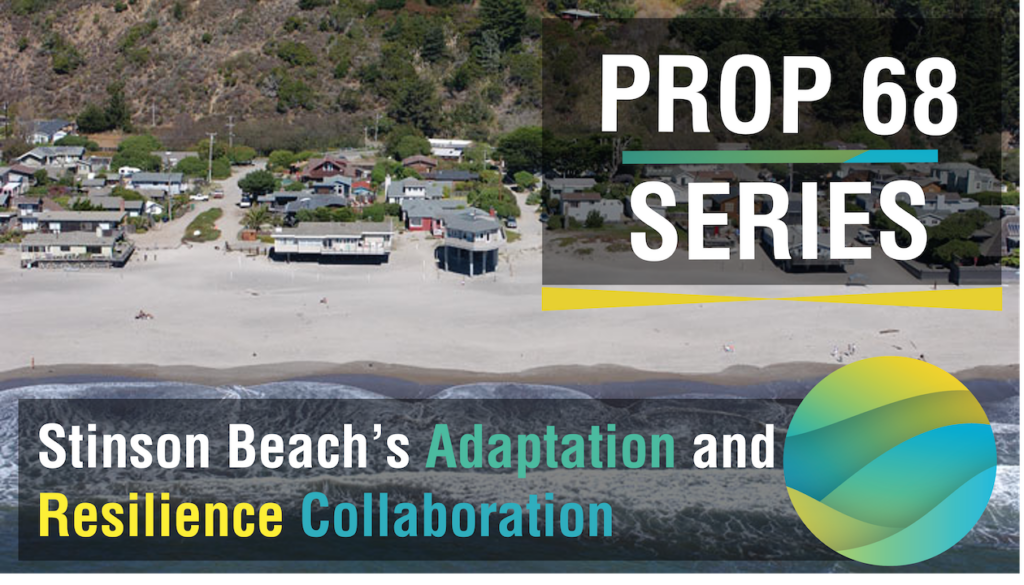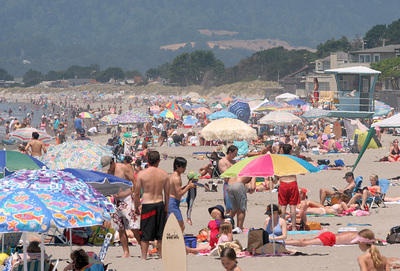Prop 68 Climate Resilience Miniseries Episode 14: Stinson Beach Adaptation and Resilience Collaboration
“The technical sea level rise studies we’ve completed to-date have shown the coastal hazard impacts we can expect in the coming decades – and that gives us the ability to share that information with the people who are going to be directly affected. That’s crucial because public awareness and understanding of these hazards is critical if we’re going to be able plan effectively for the future.” – Julia Elkin
Today we are Stinson Beach, located on the scenic Marin County coastline, talking with Julia Elkin, the Project Manager on this Prop 68 Project to develop and deliver a community adaptation planning process for Stinson Beach that addresses existing and future coastal hazard impacts and sea-level rise.

Located about an hour north of San Francisco, Stinson Beach is a highly valued California beach to both residents and visitors. Many Californians visit Stinson Beach for relief during extreme heat events or poor air quality days. Stinson Beach has immense value – and it is highly vulnerable to sea level rise. “Our opportunity now is to work with the public and plan for that slow-moving emergency that is sea level rise because the decisions that we can make now help us plan for a future that meets our community values and reduces harm to both our natural systems and human communities,” says Elkin.
Challenges with coastal erosion, flooding and storm surges are not new to Stinson Beach. That said, climate change will only exacerbate the intensity and frequency of these coastal hazards. Adaptation responses that will be explored through the Stinson Beach Adaptation and Resilience Collaboration, or Stinson ARC, will include nature-based strategies, long-term realignment of existing structures and infrastructure and structural options.
These will be evaluated and placed into adaptation pathways that detail the near term while identifying sequencing and decision points for the foreseeable future. Potential adaptation strategies and adaptation pathways will be assessed based on their engineering and technical feasibility, economic and social equity impacts, ecological performance and efficacy. “We won’t have all the answers with this preliminary phase of long term planning, but we will be able to point to a path forward – offer an adaptation strategy roadmap – as climate change reshapes the world around us,” adds Elkin.

The Stinson ARC process will follow the Plan for Adaptation to Coastal Hazards (PATCH) approach outlined in the Marin Ocean Coast Adaptation Report and will incorporate the State’s Sea Level Rise Principles for Aligned State Action.
To learn more about this project, check out this video!
Resources:
Marin County Sea Level Rise Website
Marin Ocean Coast Sea Level Rise Adaptation Report
Golden Gate National Recreation Area
Credits:
Video Production, Editing, and Narration: Kat Beheshti
Photos: County of Marin, Julia Elkin
About Julia Elkin: Julia is a Sea Level Rise Planner at County of Marin Community Development Agency. Prior to working for the County, Julia was a Project Manager for the California Coastal Conservancy. She received her B.A. in Environmental Policy from The College of William and Mary and her Master’s in Environmental Policy and Planning from University of Michigan.
About the Author: Dr. Kathryn Beheshti is a 2021 California Sea Grant State Fellow with the Ocean Protection Council’s Climate Change Program. Kat’s own research focuses on understanding the drivers of loss and recovery of key coastal foundation species (e.g. salt marsh plants and seagrasses). Kat is committed to making science accessible to individuals of all ages and demographics. She hosts her own science communication platform, sloughit.com and participates in an interdisciplinary science communication team at SciAll.org, where she is a Lead Vlogger.

